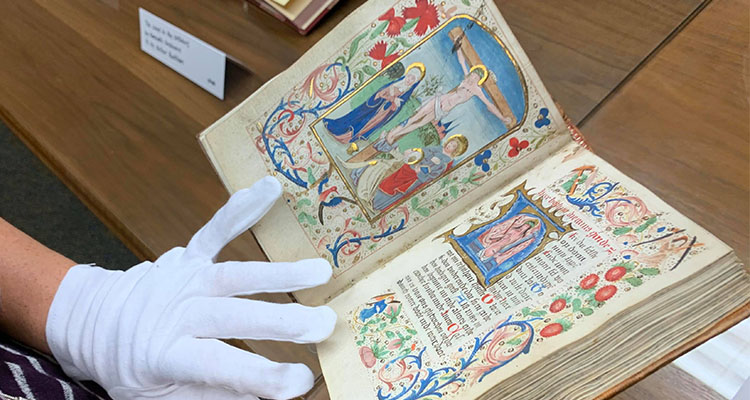We had learned a bit about the history of this type of book in our English literature class, but none of us were really prepared to see the ornate gold leaf hand-drawn pages in person.
I felt that same awe when I saw the book again in 2015 and for a third time just last week when it was returned to its humble home amongst the hills from being restored in Philadelphia, Pennsylvania.
BY THE BOOK
The book of hours is a type of Christian devotional used by laypersons in the Middle Ages. Although each book generally contained individual selections of prayers, hymns, psalms and other religious texts, every book included the Hours of the Virgin Mary.
During this time period, Christians would pray eight times per day to express their devotion to the blessed mother. Beginning at daybreak and ending at bedtime, the hours observed were called Matins, Lauds, Prime, Terce, Sext, None, Vespers and Compline.

These handmade books were often personalized for their intended owners, including Christian celebrations in their communities, the addition of their names in prayers, and spaces for recording births, deaths and other important information. Although heavily illuminated books of hours could be incredibly expensive, smaller books with no illuminations were affordable enough for the lower classes to own. Later, the printing press made it possible to mass produce books of hours, which limited the kinds of personalization available.
Referred to by some experts as “a Medieval bestseller,” the book of hours was popular across genders and social classes. It is estimated that tens of thousands of these books remain in existence, mostly because they were treasured heirlooms passed down from one generation to the next.
In addition, the vast majority of the books of hours were made out of nearly indestructible materials. Most of the books were transcribed on vellum, which was made from the skins of young animals, such as piglets or calves. The skin would be scrapped clean of flesh and hair and stretched thin before being cut to size. These pages, then, would be hand-sewn together to form the book.
ONCE UPON A BLUE-HAIRED GODDESS
West Liberty University’s copy of Horae Beatae Mariae Virginis (or book of hours) was presented to the school by Henry Lash, a former student of Professor Nelle Krise and an accomplished pianist from Colerain, Ohio.
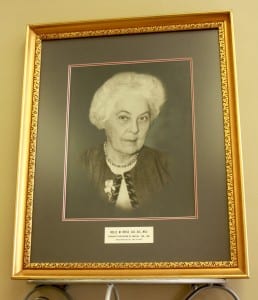
She had given the book to Lash as a gift from her one-of-a-kind collection of books, scrolls and other priceless documents she had collected during her tenure at West Liberty.
Lash, unsure of how to take care of such a valuable possession, wrapped it in aluminum foil and stashed it in his freezer for a few years before donating it to the school’s Elbin Library — still wrapped in the aluminum foil barrier.
Professor Krise remains a legend at West Liberty, where she taught English language and literature from 1926 to 1966. She was well-loved and well-respected by students and colleagues alike, and she often invited them into her home to enjoy high tea in her parlor.
In a remembrance of Krise, former West Liberty University President Clyde Campbell recalled her kind, quiet nature. “She would often,” he said, “get lost in her own recitations of great poetry, especially Wordsworth, whom she adored.”
Campbell, who was one of Krise’s students and later her colleague, lived near her in university housing. He said that she was affectionally known around campus as “the blue-haired goddess” because of a special blue rinse that she used on her graying hair.
Her great passion was the written word, and she spent her summers and holiday breaks from the college in England, where it is assumed that Krise purchased the book. Little else is known about the origins of the 110-page, Dutch volume.
Completely intact books of hours are uncommon because most of them were parceled out page by page to book buyers over the centuries. Given the quality and kind of illuminations, it is believed that the book would have been owned by someone from a wealthy family.
In addition to the book of hours, Krise donated her entire collection of rare manuscripts and other materials to the Elbin Library upon her death in 1981. The Nelle M. Krise Rare Books Room at West Liberty University contains priceless works of the written word, including an invaluable piece of Egyptian papyrus from 30 B.C. that was formerly owned by newspaper magnate William Randolph Hearst and a Babylonian cuneiform tablet that was used as a receipt for the sale of sheep and goats. It dates to around 2350 B.C.
TOUCHING HISTORY
As an English major at West Liberty in the mid-1990s, I, too, was captivated by the history of the written word and fell in love with the mystique of Nelle Krise. In fact, I lived in the student dormitory named after her during my senior year. I recall listening with rapt attention each time one of my professors recounted first-hand stories of her.
When the time finally came for our class to enter the hallowed Rare Book Room that day in 1994, I couldn’t wait to study the book of hours, which had become the centerpiece of the collection. Unfortunately, there would be no time for studying and certainly no opportunity to see the book outside of the bounds of its glass-lidded container.
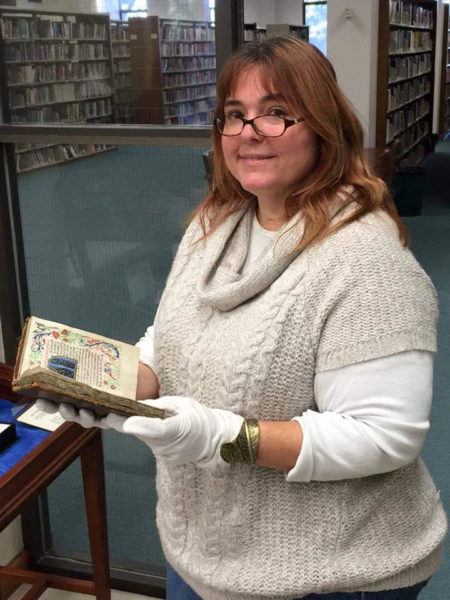
Although the gloriously illuminated double-page spread thrilled me beyond measure, I was disappointed that I couldn’t smell the book (as a lover of books would do) or carefully turn a few of its pages. I understood, of course, that its importance required that it be well-preserved, but I went back to class a little heartbroken to have been so close to such an exquisite object and yet so far away.
Twenty years later, I returned with my own students from California University of Pennsylvania. They were at the library to conduct research for a digital storytelling project they were creating about the Rare Books Room. I had told them all about the book of hours before we arrived, but they did not seem impressed.
We entered the small humidity- and UV-controlled room on the second floor of Elbin Library and to our immediate right spotted the book, still in its original display case. I told the head librarian my story of woe regarding the last time I saw the book, and she instantly said, “Oh my. Well, you can hold it if you want to.”
I was so stunned that I could not even say, “Yes, please.” Within minutes, she and I had donned white gloves, and she was handing me a book written in the 15th century by monks. I took it from her gingerly, cradling it in the same way I had taught my students, and began gently weeping. In that moment, I was touching a beloved book that had been passed through the ages for more than 500 years; a book that Nelle Krise herself had once owned and passed around her classrooms to her students.
My own students were in awe at the sight of their professor overcome with emotion. Later, they would tell me that in my moment of joyful tears that they realized what writing and books really meant to me.
But it was more than just the book that made me swell with happiness. It was in that moment when I realized that I had become what I had dreamed while staring in at the untouchable book two decades prior. Like Nelle Krise, I had become an English professor, and like her, I was inspiring my students to appreciate the written word.
Although there will never be another Nelle Krise, her hard work and commitment to her favorite saying, “You only have what you give away,” lives on in the spirit of the students she taught for 40 years and the Rare Book Room.
THE HOMECOMING
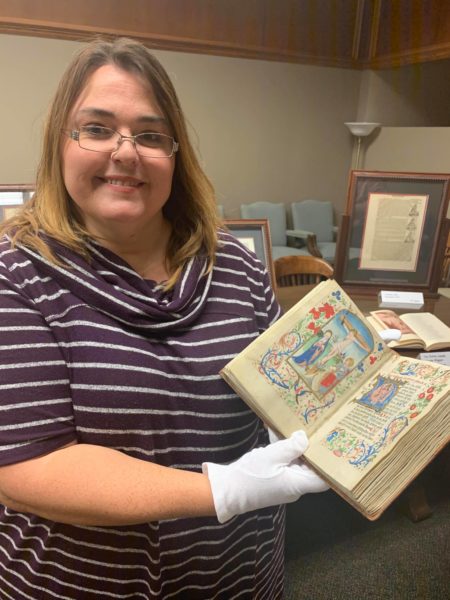
Four years later, I found myself holding that same book in my white-gloved hands at a special reception to welcome the book home to West Liberty University. Cheryl Harshman, who retired as head librarian in June 2019, had started the long process of having the book of hours professionally preserved in the hopes that it will spark some future student’s love of learning the way it did mine
Harshman worked with lead donor Jeremy McCamic and others to secure the more than $12,000 necessary for the Conservation Center for Art and Historic Artifacts in Philadelphia (CCAHA) to gently clean the pages, repair the binding, and generally, to improve the book’s already good condition for generations to come. Harshman drove the book to the Conservation Center to ensure that it arrived safely.
Eight months later, after the CCAHA’s conservationist’s devoted hours and hours of painstaking work, Katie Zane, who replaced Harshman as WLU’s librarian, drove the 600-mile roundtrip to Philadelphia to bring the book home to the Rare Books Room.
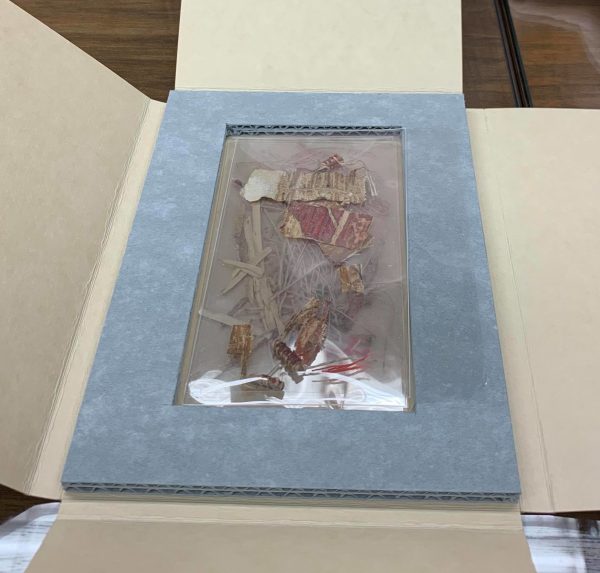
On Thursday, Nov. 7, Zane brought the historic volume, along with other pieces from West Liberty’s special collections to the reception for the book of hours held at West Liberty University’s Downtown Center at 1310 Market St.
Following joyful reminisces by former President Campbell, two West Liberty University professors spoke about their knowledge of the book. Art professor Brian Fencl talked about the rare pigments and gold leaf used to create the illustrations throughout the book, making special reference to the tediousness of the task. Then, dean of the College of Arts and Sciences, Gerard Necastro, spoke about the history of the book of hours, including how it was created and used, both as a work of art and a religious object.
For a detailed overview of the work done to the book, including before and after photos, see the CCAHA website. To view the book of hours in person, make an appointment by calling the West Liberty University Elbin Library at 304-336-8261.
Although the book of hours is once again back in the Nelle M. Krise Rare Books Room, it is no longer in its glass case. Instead, it has been moved to a brand new safe to ensure its security and longevity.
• Christina Fisanick, Ph.D., is an associate professor of English at California University of Pennsylvania, where she teaches expository writing, creative non-fiction and digital storytelling. She is the author of more than 30 books, including her most recent memoir, “The Optimistic Food Addict: Recovering from Binge Eating Disorder.” She has been a Weelunk contributing writer since 2015. Christina is a 1996 graduate of West Liberty University and a member of Ohio Valley Writers. She lives in Wheeling with her family.


